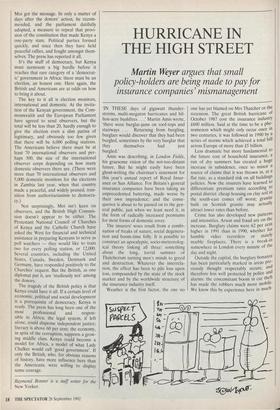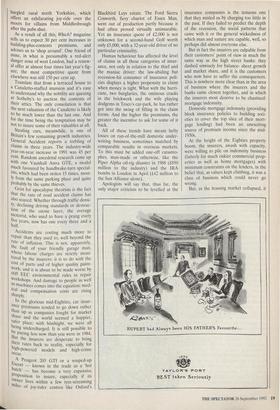HURRICANE IN THE HIGH STREET
Martin Weyer argues that small
policy-holders are being made to pay for insurance companies' mismanagement
`IN THESE days of gigawatt thunder- storms, multi-megaton hurricanes and bil- lion-acre bushfires ...' Martin Amis wrote, `there were burglar-jams on roof-tops and stairways ... Returning from burgling, burglars would discover that they had been burgled, sometimes by the very burglar that Amis was describing, in London Fields, his gruesome vision of the not-too-distant future. But he might easily have been ghost-writing the chairman's statement for this year's annual report of Royal Insur- ance or Sun Alliance. For Britain's general insurance companies have been taking an unprecedented battering, made worse by their own imprudence; and the conse- quence is about to be passed on to the gen- eral public, just when we least need it, in the form of radically increased premiums for most forms of domestic cover.
The insurers' woes result from a combi- nation of freaks of nature, social degenera- tion and boom-time folly. It is possible to construct an apocalyptic, socio-meteorolog- ical theory linking all three: something about the long, torrid summer of Thatcherism turning men's minds to greed and destruction. Whatever the interrela- tion, the effect has been to pile loss upon loss, compounded by the state of the stock market and by the worldwide structure of the insurance industry itself.
Weather is the first factor, the one no one has yet blamed on Mrs Thatcher or the recession. The great British hurricane of October 1987 cost the insurance industry £600 million. Said at the time to be a phe- nomenon which might only occur once in two centuries, it was followed in 1990 bya series of storms which achieved a total bill across Europe of more than £5 billion.
Less dramatic but more fundamental to the future cost of household insurance, a run of dry summers has created a huge increase in subsidence, once so minor a source of claims that it was thrown in, at a flat rate, as a standard risk on all buildings policies. Now the insurers have learned to differentiate premium rates according to postal district: cheap housing on clay soil in the south-east comes off worst; granite built on Scottish granite may actually attract lower rates than before.
Crime has also developed new patterns and intensities. Arson and fraud are on the increase. Burglary claims were 62 per cent higher in 1991 than in 1990, whether for humble video recorders or stately marble fireplaces. There is a break-in somewhere in London every minute of the day and night.
Outside the capital, the burglary bonanza has been particularly marked in areas pre- viously thought respectably secure, and therefore less well protected by police and alarms: the concomitant boom in car the has made the robbers much more mobile. We know this by experience here in much-
burgled rural north Yorkshire, which offers an exhilarating joy-ride over the moors for villains from Middlesbrough after the pubs shut.
As a result of all this, Which? magazine tells us to expect 30 per cent increases in
building-plus-contents premiums, and advises us to 'shop around'. One friend of mine, in what is presumably a red-alert, danger zone of west London, had a renew- al offer at almost four times last year's fig- ure; the most competitive quote from elsewhere was still 150 per cent up. Translate that from a terraced house to a Canaletto-stuffed mansion and it's easy to understand why the nobility are queuing at Sotheby's to auction the contents of their attics. The only consolation is that the next valuation of the Canaletto is likely to be much lower than the last one. And for the time being the temptation may be not to insure some of their valuables at all.
Stealing cars, meanwhile, is one of Britain's few remaining growth industries. General Accident reports a treblingof claims in three years. The industry-wide year-on-year increase in 1991 was 45 per cent. Random anecdotal research came up with one Vaukhall Astra GTE, a model Much favoured by handbrake-turn special- ists, which had been stolen 15 times, most- ly from the same parking place and quite probably by the same thieves. Grist for apocalypse theorists is the fact that the rate of road accident claims has also soared. Whether through traffic densi- ty, declining driving standards or destruc- tion of the ozone layer, the average motorist, who used to have a prang every five years, now has one every three and a half.
Accidents are costing much more to repair than they used to, well beyond the rate of inflation. This is not, apparently, the fault of your friendly garage man, whose labour charges are strictly moni- tored by the insurers; it is to do with the
cost of parts and of higher quality paint- work; and it is about to be made worse by
stiff EEC environmental rules in repair workshops. And damage to people as well as machines comes into the equation: med- ical and compensation costs are rising sharply. In the glorious mid-Eighties, car insur- ance premiums tended to go down rather than up as companies fought for market share and the world seemed a happier, safer place; with hindsight, we were all being undercharged. It is still possible to be paying less now than you were in 1984.
But the insurers are desperate to bring their rates back to reality, especially for high-powered models and high-crime areas.
A Peugeot 205 GTI or a souped-up Escort — known in the trade as a 'hot hatch, — has become a very expensive Proposition to insure, especially if its owner lives within a few tyre-screaming Miles of joy-rider centres like Oxford's Blackbird Leys estate. The Ford Sierra Cosworth, fiery chariot of Essex Man, went out of production partly because it had often proved virtually uninsurable. Yet an insurance quote of £2,000 is not unknown for a second-hand Golf worth only £5,000, with a 32-year-old driver of no particular criminality.
Human behaviour has affected the level of claims in all these categories of insur- ance, not only in relation to the thief and the maniac driver: the law-abiding but recession-hit consumer of insurance poli- cies displays a higher propensity to claim when money is tight. What with the hurri- cane, two burglaries, the ominous cracks in the brickwork and the wife playing dodgems in Tesco's car-park, he has rather got into the swing of filling in the claim forms. And the higher the premiums, the greater the incentive to ask for some of it back.
All of these trends have meant hefty losses on run-of-the-mill domestic under- writing business, sometimes matched by comparable results in overseas markets. To this must be added one-off catastro- phes, man-made or otherwise, like the Piper Alpha oil-rig disaster in 1988 (£850 million to the industry) and the IRA bombs in London in April (£42 million to the Sun Alliance alone).
Apologists will say that, thus far, the only major criticism to be levelled at the insurance companies is the tenuous one that they misled us by charging too little in the past. If they failed to predict the depth of the recession, the social patterns that came with it or the general wickedness of which man and nature are capable, well, so perhaps did almost everyone else.
But in fact the insurers are culpable from their customers' point of view in much the same way as the high street banks: they dashed unwisely for balance- sheet growth and market share, and it is the customers who now have to suffer the consequences. This is nowhere more clear than in the area of business where the insurers and the banks came closest together, and in which the insurers most deserve to be chastised: mortgage indemnity.
Domestic mortgage indemnity (providing block insurance policies to building soci- eties to cover the top slice of their mort- gage lending) had been an unexciting source of premium income since the mid- 1930s.
At the height of the Eighties property boom, the insurers, awash with capacity, were willing to pile on indemnity business (latterly for much riskier commercial prop- erties as well as home mortgages) with minimum constraints on the lenders, in the belief that, as values kept climbing, it was a class of business which could never go wrong. But, as the housing market collapsed, it went wrong in the most spectacular way. Mortgage indemnity cost the insurance industry up to £1.5 billion in 1991, and losses will continue to mount through this year and next.
Just as the banks deny that they are going to put charges back on current accounts to recoup some of their loan losses, so the insurers are anxious to tell us there is no direct correlation between dis- asters in one category of business and pre- mium rises in another. The householder or the motorist is not, they say, picking up the tab for Piper Alpha or the folly of mort- gage indemnity; competition within each category determines what level of premi- um the market will accept. But the argu- ment is unconvincing, because the state of most insurance companies' balance sheets dictates a new degree of conservatism across the board.
The truth is that several major insurers have lost as much as half of their share- holders' funds in the past two years, and their solvency ratios (of capital to premi- um income) are at a low ebb. Dividends have been passed or cut and there have been suggestions, vigorously denied, that in some cases reserves may prove inade- quate for future claims. And even if the worst losses in the more predictable cate- gories of business have now come out of the woodwork, the outlook for profits to come — and so the opportunity of rebuild- ing reserves — is adversely affected by other structural trends in the industry.
First, insurers rely on reinsurance to lay off their risks. The reinsurance market, of which Lloyd's is an important element, is a global one which has, in the past five years, taken the brunt of everything from the Exxon Valdez oil slick to Typhoon Mireille in Japan and is now counting the cost of Hurricane Andrew in Florida. As a result, world reinsurance capacity has shrunk (all those Lloyd's resignations, for example) and rates have risen, leaving domestic insurers facing squeezed margins or greater net risk exposures, or both.
Second, insurers rely on investment income on their own capital and on their long-term claims reserves to offset losses on basic underwriting business. They now face an era of low stock-market perfor- mance, related to low inflation, giving lower returns on already depleted reserves. All the more important, therefore, to strive for more satisfactory results at the net underwriting level, which is possible only by hiking premiums wherever they can and by shedding high-risk business.
It seems symbolic that a brand-new building in the City housing the London Underwriting Centre, a pink Gothic folie de grandeur called Minster Court, should have gone up in a pillar of flame last year. Perhaps burglars had removed the extin- guishers. It is expected to be the largest single fire claim in British insurance histo- ry. You may rest assured that we shall all, indirectly, be paying for it.




































































 Previous page
Previous page